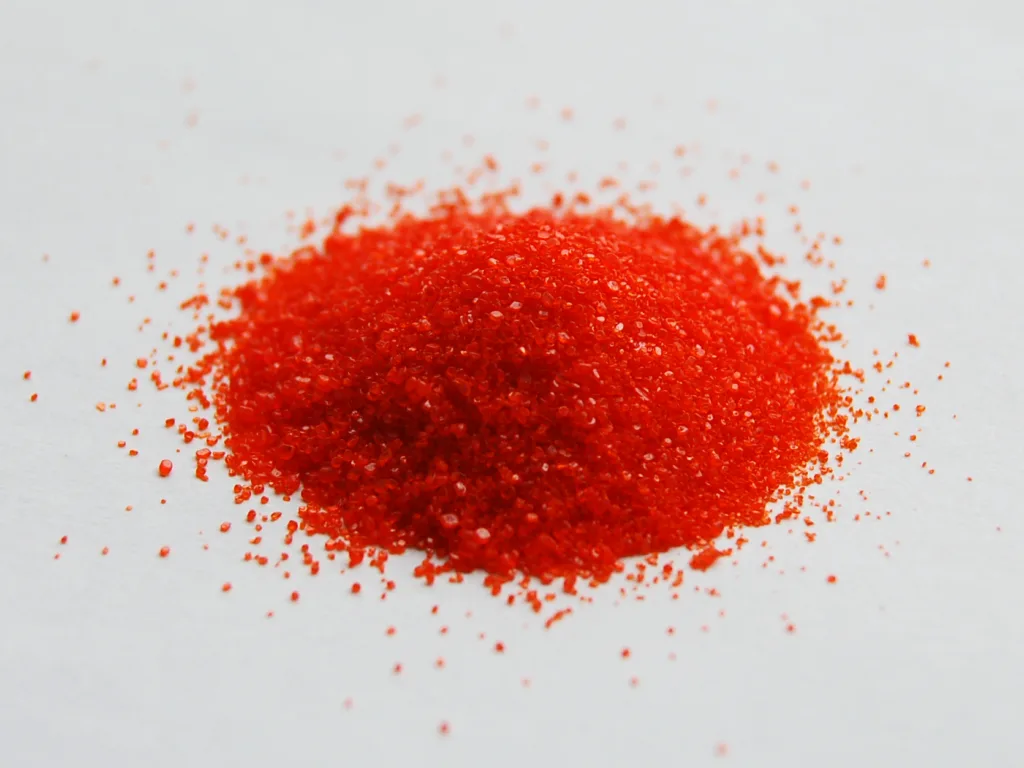Potassium dichromate, also known as K2Cr2O7, is a common inorganic chemical reagent that is widely used in laboratories and industries. Its chemical formula is derived from the element chromium, which is a metal that is abundant in the earth’s crust. Potassium dichromate is an orange to red, crystalline (sand-like) solid or powder that is odorless and has a molecular mass of 294.185 g/mol.
One of the most common uses of potassium dichromate is as an oxidizing agent. In laboratories, it is used as a reagent for various chemical reactions that require the transfer of electrons. It is also used in the production of pigments, dyes, and other chemicals. In industries such as tanning, painting, printing, electroplating, and pyrotechnics, potassium dichromate is used to achieve specific chemical reactions and properties.
However, potassium dichromate can also pose health risks to humans and the environment. Chromium and chromates are naturally occurring in the environment, including in soil and water. They are also found in products made of chrome, stainless steel, cement, and leather. Exposure to high levels of potassium dichromate can cause skin irritation, respiratory problems, and even cancer. In addition, chromate is a cause of occupational dermatitis in bricklayers, construction workers, and metal workers.
Therefore, it is important to handle potassium dichromate with caution and to follow proper safety procedures when working with it. This includes wearing protective gear such as gloves, goggles, and respirators, as well as working in a well-ventilated area. Proper disposal of potassium dichromate is also crucial to prevent environmental contamination.
Potassium dichromate is a versatile and widely used chemical reagent that has both benefits and risks. While it is essential for many laboratory and industrial processes, it is important to handle it with care and to be aware of its potential health and environmental hazards. By following proper safety protocols and disposal procedures, we can ensure that we use potassium dichromate responsibly and safely.
What Is Potassium Dichromate Used In?
Potassium Dichromate is a versatile chemical compound that finds its application in various fields. Some of the common uses of Potassium Dichromate include:
1. Analytical Reagent: Potassium Dichromate is commonly used as an analytical reagent in laboratories for testing the presence of various substances such as alcohol, aldehydes, and ketones.
2. Tanning: Potassium Dichromate is used as a tanning agent in the leather industry. It helps in stabilizing the leather and imparting a durable finish to it.
3. Painting: Potassium Dichromate is used as a pigment in the production of paints, inks, and dyes. It gies a bright orange color to the paint and enhances its lightfastness.
4. Printing: Potassium Dichromate is used in the printing industry to produce photoengravings and lithographic plates. It is also used in the production of screen printing stencils.
5. Electroplating: Potassium Dichromate is used in electroplating to give a protective coating to metals such as aluminum, zinc, and copper.
6. Pyrotechnics: Potassium Dichromate is used in the production of fireworks to give a bright orange color to the flames.
Potassium Dichromate is a versatile chemical compound that is used in various industries for its unique properties and properties.

Is Potassium Dichromate In Leather?
Potassium dichromate is commonly used in the leather tanning process as an oxidizing agent. Its ability to crosslink collagen fibers in the leather gives it greater durability and resistance to water. However, the use of potassium dichromate has been heavily regulated and restricted due to its toxic nature and potential harm to human health and the environment. In some countries, its use has been banned altogether, and alternative, less harmful tanning methods have been developed.
Does Stainless Steel Contain Potassium Dichromate?
Stainless steel is an alloy made of iron, carbon, and othr elements such as nickel, chromium, and molybdenum. While chromium is a common component of stainless steel, it is not present in the form of potassium dichromate. Potassium dichromate is a compound consisting of potassium, chromium, and oxygen, and it is not typically added to stainless steel during its manufacturing process. However, it is possible that trace amounts of potassium dichromate could be present in stainless steel due to contamination from other sources. Nonetheless, the levels of potassium dichromate in stainless steel are generally very low and not considered to be a significant health risk.
Where Are Chromates Found?
Chromates can be found in a variety of sources, including industrial processes such as metal plating and chemical manufacturing. They are also present in certain types of cement, particularly those that have not yet dried. Additionally, chromates are commonly used as pigments in paints and dyes, and can be found in some fertilizers and pesticides. Due to their widespread use in industrial and commercial applications, chromates can also be found in the air, soil, and water in areas surrounding thee facilities. Occupational exposure to chromates is a concern for workers in industries such as construction, metalworking, and painting, as exposure can lead to dermatitis and other health issues.
Conclusion
Potassium dichromate is a commonly used inorganic chemical reagent in laboratories and industries as an oxidizing agent. It has a molecular mass of 294.185 g/mol and is commonly used in tanning leather, painting, printing, electroplating, and pyrotechnics. However, it is important to note that potassium dichromate is a chromium salt or chromate, and exposure to it can caue occupational dermatitis in workers such as bricklayers, construction workers, and metal workers. It is also found naturally in soil and water, as well as in products made of chrome, stainless steel, and cement. Therefore, it is crucial to handle and dispose of potassium dichromate properly to avoid any harmful effects on human health and the environment.
